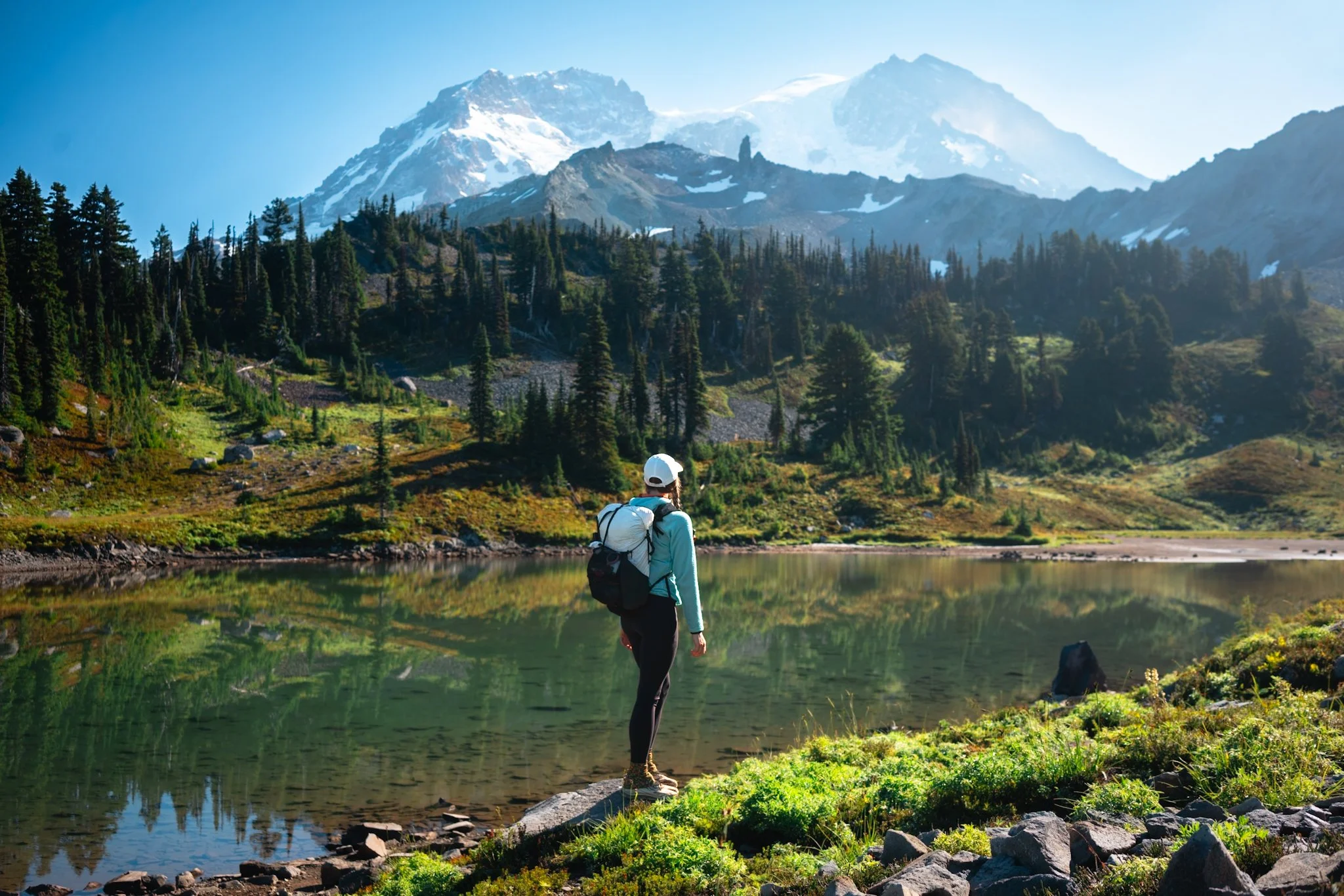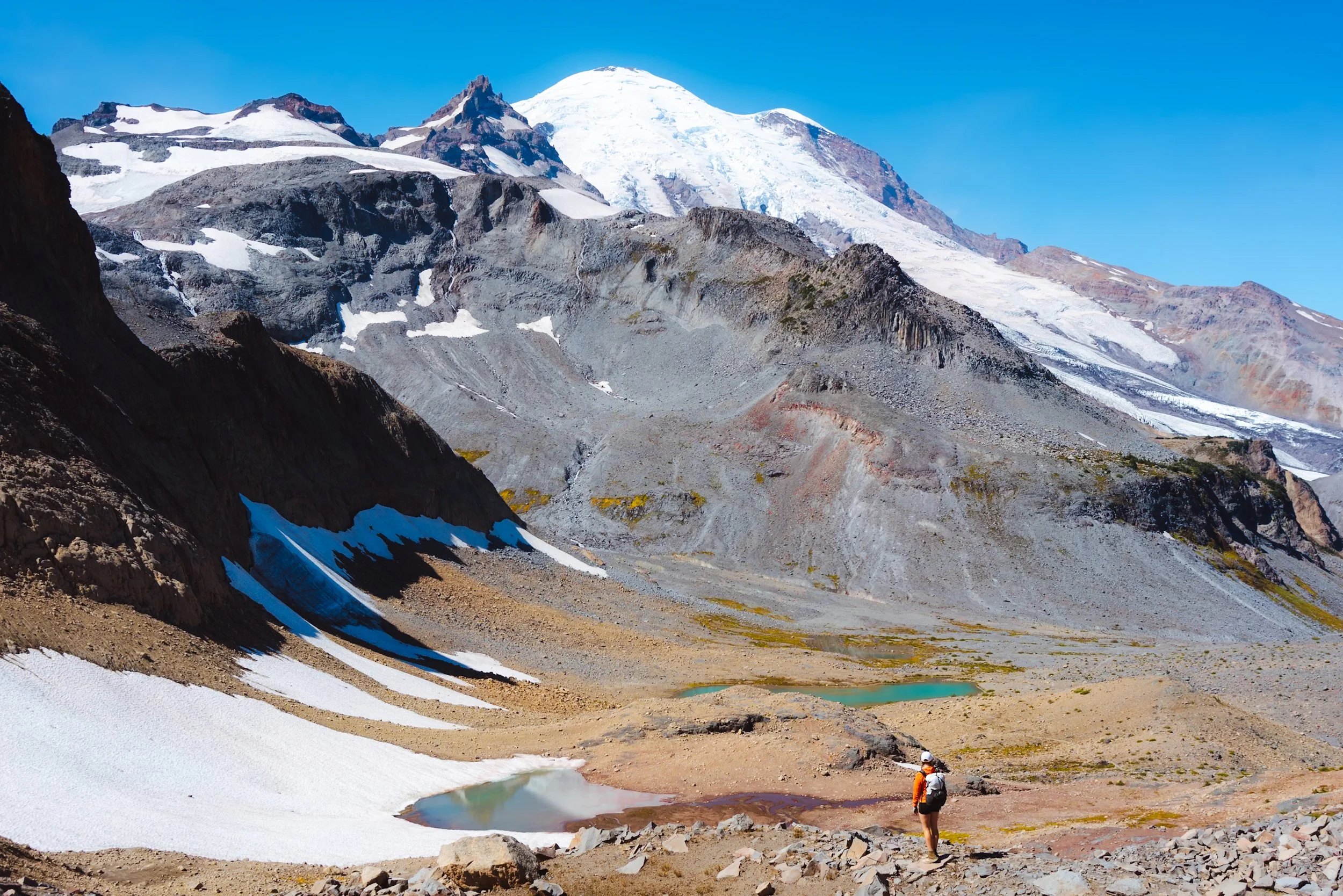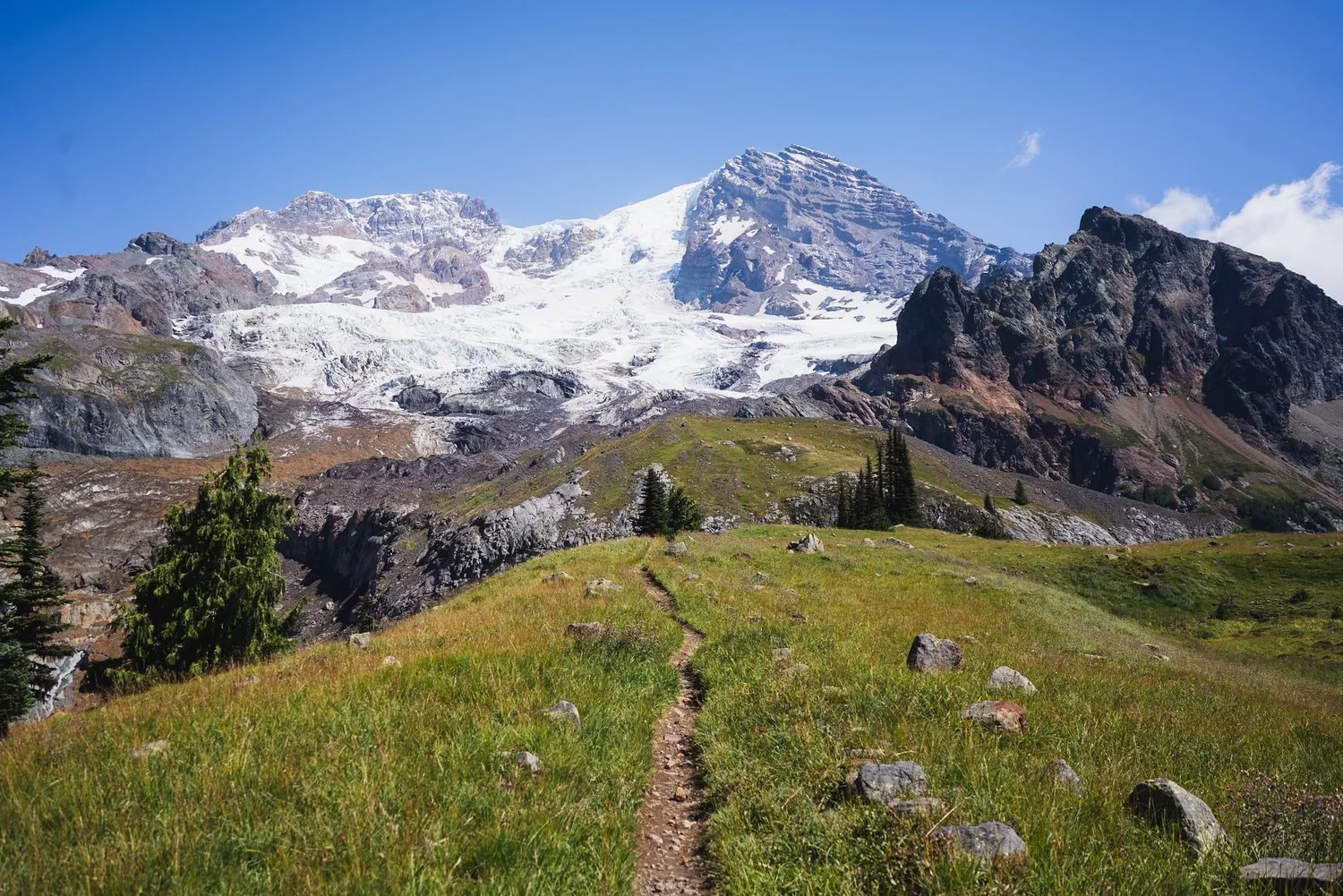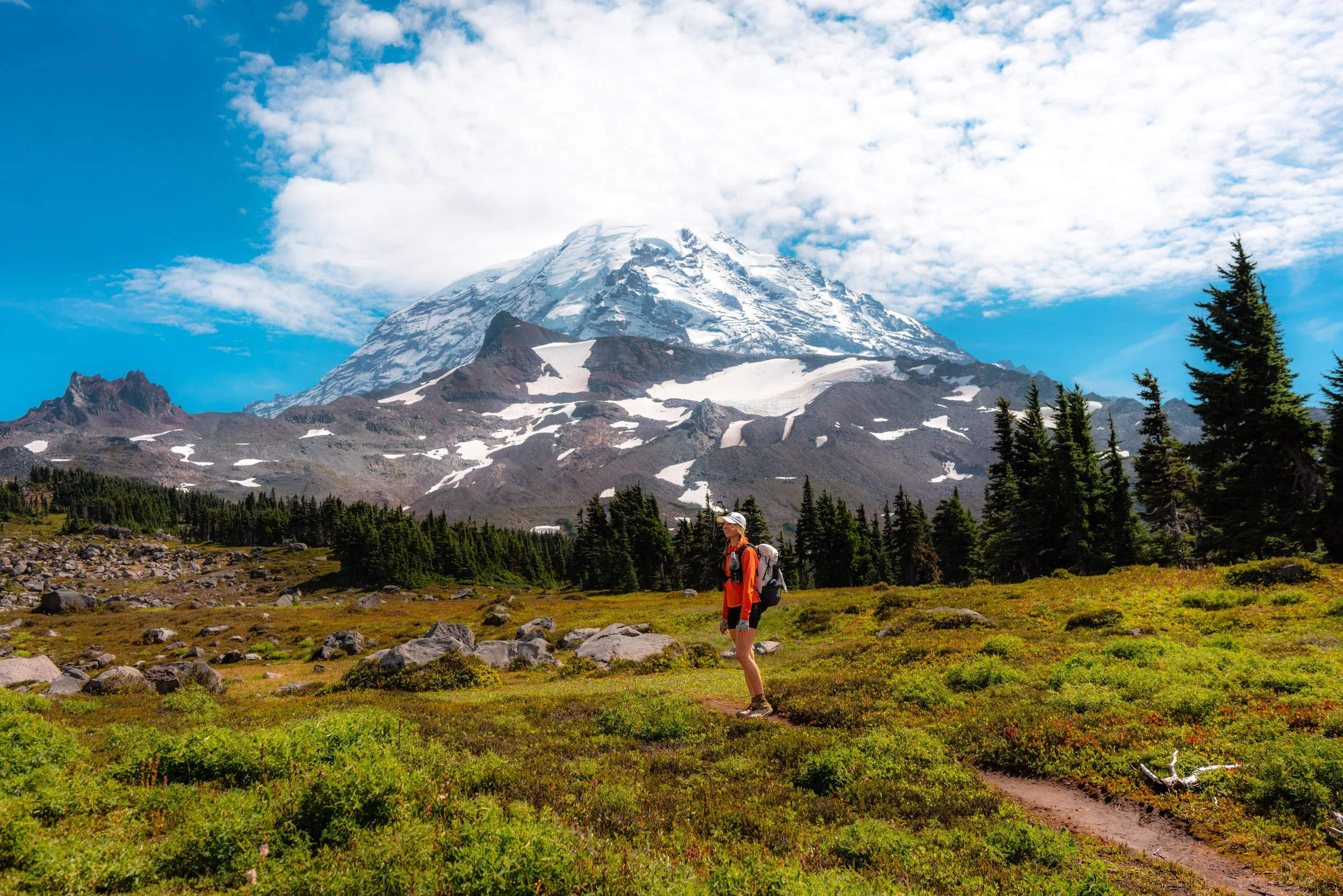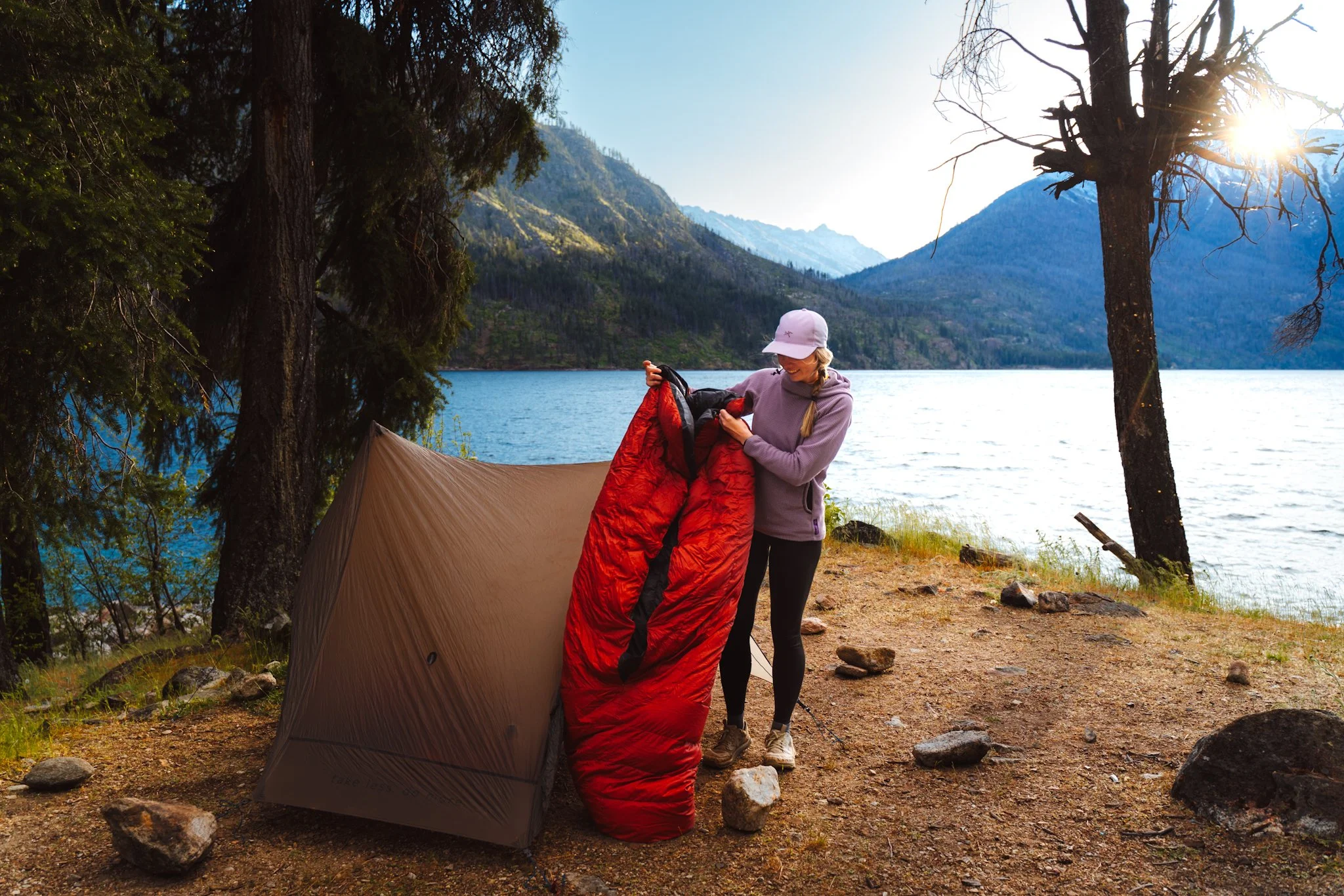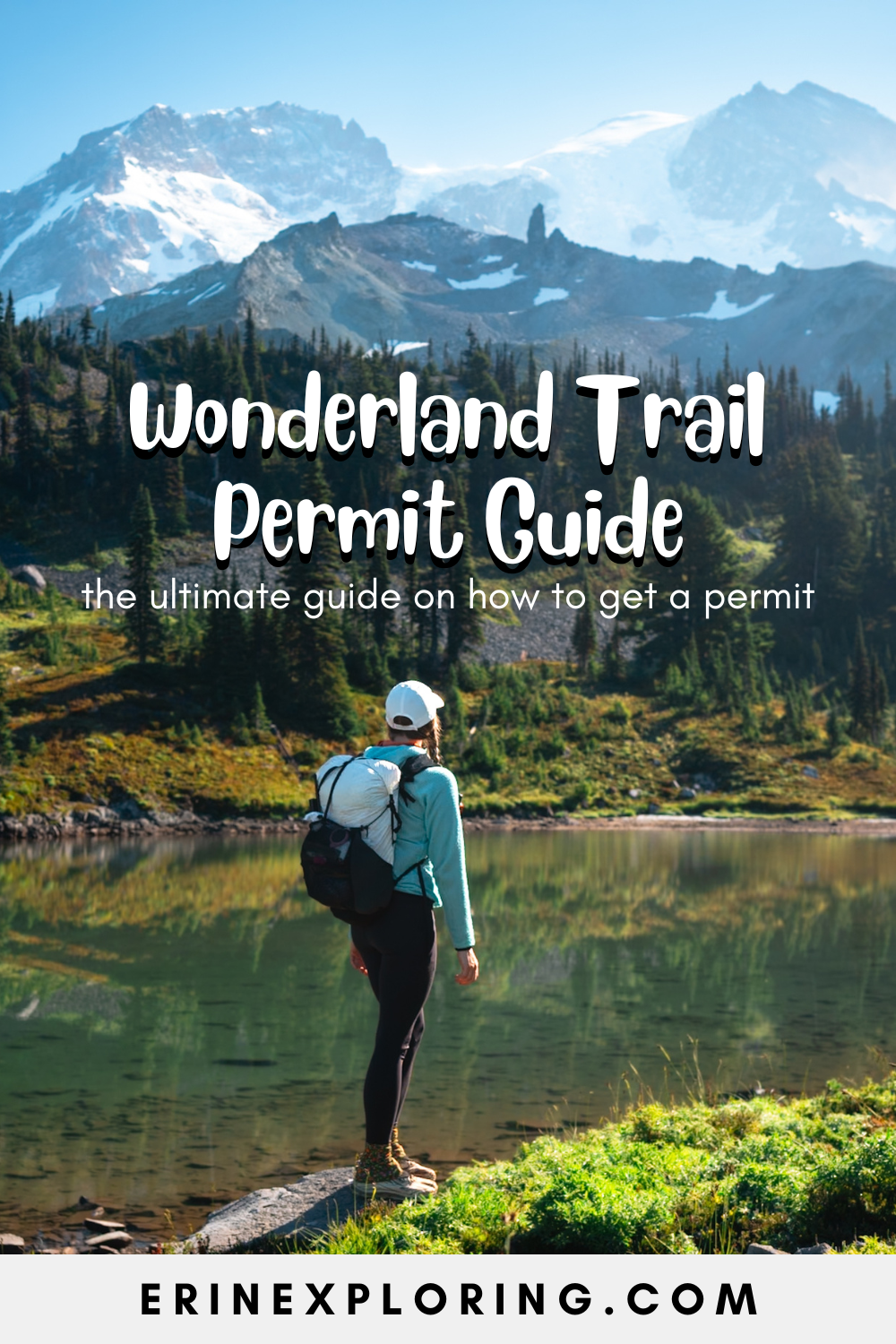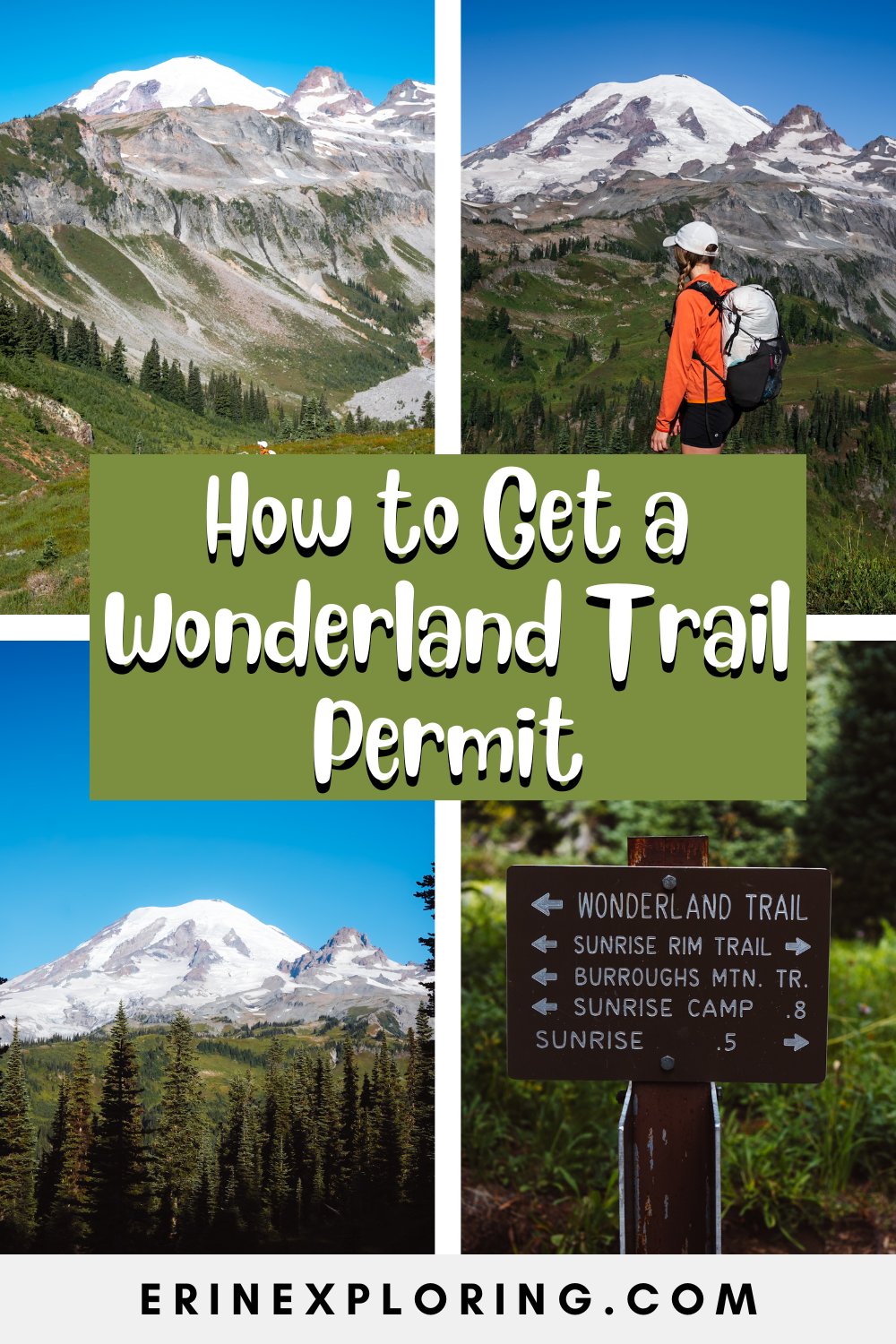How to Get a Wonderland Trail Permit in 2025: The Ultimate Guide
In 2024, I thru-hiked the Wonderland Trail, which is a 93-mile trail that circles Mount Rainier in Washington State. The Wonderland Trail is entirely within Mount Rainier National Park, which requires permits for backpacking and camping in the designated backcountry campsites. To camp on the Wonderland Trail, you must obtain a backcountry permit from Mount Rainier National Park. Permits are required year-round for all overnight stays in the park’s backcountry and you will need to reserve a campsite for each night of your trip. Dispersed camping is not allowed along the Wonderland Trail. Backcountry permits in Mount Rainier National Park are very popular and competitive to get, so understanding the permit process is important for planning your Wonderland Trail hike.
This Wonderland Trail permit guide covers everything you need to know to get a Wonderland Trail permit in 2025, whether it’s through the Early Access Lottery, the General Permit Release, or Walk-Up Permits.
Table of Contents:
Let’s Connect: Instagram • TikTok • YouTube • Join My Newsletter | Enjoy This Post? Ways to Support this Blog
View of Mount Rainier from Panhandle Gap on the Wonderland Trail
Wonderland Trail Map with Campsites & Trailheads
This map of the Wonderland Trail (from Mount Rainier’s Wilderness Trip Planner) includes the campsites and main trailheads. Use this map as a reference while planning your hike and booking permits. I highlighted the main Wonderland Trail route in pink, the Spray Park alternate in green, and the major trailheads in orange. For a full version of the map, go to the Wilderness Trip Planner. Another useful tool is the Wilderness Trip Planner Aid, which includes mileages and estimated campsite snow melt-out dates.
If you want full map sets of the Wonderland Trail, I took these paper maps with me on the Wonderland Trail (these maps are also a good option). I also purchased the FarOut Wonderland Trail Map on my phone. I personally like FarOut because hikers can add comments and updates on water sources, bridges, etc.
This map is for illustrative purposes only and should not be used for navigation. Full version of this map: Wilderness Trip Planner
Key Wonderland Trail Permit Info:
When Are Permits Required?
Permits are required year-round for all overnight stays in the backcountry of Mount Rainier National Park, including camping on the Wonderland Trail.
Where to Reserve Permits Online
Recreation.gov: Mount Rainier National Park Wilderness and Climbing Permits
Permit Availability & Ways to Get a Wonderland Trail Permit
There are three ways to get a Wonderland Trail permit:
Early Access Lottery: This is your best chance to secure a full itinerary (but doesn’t guarantee it). Applications for the lottery open February 10–March 3, 2025 and results are announced March 14, 2025. If you are selected as a lottery winner, you will get early access to reserve backcountry campsites before general reservations open. If you win, you'll be given a time slot during the Early Access Period to try to book permits, which starts March 21, 2025.
General Permit Release: After the Early Access Period for lottery winners, the remaining reservable backcountry permits/sites will be available for online reservation to the public starting April 25, 2025.
Walk-Up Permits: The remaining 1/3 of backcountry permits are available first-come, first-served at Mount Rainier National Park Wilderness Information Centers. These can be obtained the same day or the day before you want to start your hike.
Camping Restrictions
All camping along the Wonderland Trail must be in designated campsites with a valid permit. Dispersed camping is not allowed. You must book a campsite for every night of your Wonderland Trail trip.
Permit Fees
$10 per person per night (youth under 15 are free) + $6 reservation fee (credit/debit card only)
Max Group Size
Standard Campsites: Up to 5 people in a single site
Group Sites: 6-12 people & you must use (and reserve) designated group sites
Food Storage on the Wonderland Trail
Each backcountry campsite in Mount Rainier National Park has either a metal pole with hooks for hanging food bags or bear-proof food lockers. Bring some sort of dry bag or stuff-sack that can hang from a hook to hang your food and trash with.
Food storage poles (bear poles) on the Wonderland Trail for hanging your food and trash
Daily Mileage Limit When Booking Wonderland Trail Permits Online
Recreation.gov enforces a 17.5-mile daily limit when booking campsites online, mainly to prevent you from creating an overly ambitious or unrealistic itinerary. It looks like the mileage used in Recreation.gov comes from Mount Rainier National Park’s Wilderness Trip Planner (the mileage in the planner seems to be less/slightly different compared to other Wonderland Trail resources). For example, I used Hiking Tahoma Planner to plan my Wonderland Trail itinerary and it lists slightly longer distances than the Wilderness Trip Planner. So according to Hiking Tahoma Planner, a couple of my days were 17.8+ miles, but according to the Wilderness Trip Planner, they were under 17.5 miles, so I was still able to book these days on Recreation.gov.
On Recreation.gov, if you try to book campsites for a day that’s farther than 17.5 miles from your previous night’s campsite, those sites won’t appear as available. However, there’s a slight workaround to the mileage limit: you can select starting or ending trailheads that are farther than 17.5 miles from the first/last night’s campsite. Additionally, if you want to cover more miles in a day, you can modify your itinerary or try to secure those campsites in person or by contacting one of the Wilderness Information Centers/Ranger Stations after the Early Access Period ends.
Permit Pick-Up
You must pick up your permit in person at a Mount Rainier National Park Ranger Station or Wilderness Information Center before starting your hike.
Total Number of Wonderland Trail Itineraries Issued Each Year
Mount Rainier National Park estimates that they issue approximately 600 online-reservable Wonderland Trail itineraries and that around 300 walk-up Wonderland Trail permits are issued annually.
If you aren’t able to build a full Wonderland Trail itinerary, backcountry permits could be available for partial Wonderland Trail section hikes or other backcountry trips.
Additional Guidelines & Rules
The Ten Essentials: Always carry the Ten Essentials.
No Pets Allowed: Dogs and other domestic animals are prohibited on the Wonderland Trail.
Firearms: The use of firearms is prohibited in Mount Rainier National Park.
Leave No Trace
Please remember to Leave No Trace when hiking the Wonderland Trail. Pack out all trash, camp in designated sites, and respect the trail, wildlife, and other hikers.
View of Mount Rainier on Wonderland Trail near Box Canyon Trailhead, Gear in photo: backpack, shorts, sun hoodie, hat, hiking shoes, sun gloves, gaiters
Important 2025 Dates for Wonderland Trail Permits
February 10, 2025: Early Access Lottery application opens at 7:00 am PT.
March 3, 2025: Early Access Lottery application closes at 7:00 pm PT.
March 14, 2025: Early Access Lottery results are announced and you are notified if you won a permit beginning at 7:00 am PT.
March 21, 2025 (Early Access Period Begins): Early Access reservations for lottery winners open for trips between the end of May and the first federal Holiday in October (late May 2025–Sun, Oct 12, 2025). Lottery winners will be assigned a time slot (time and date) that they can try to reserve permits.
April 25, 2025: General Permit Release reservations start at 7:00 am PT for trips starting between the end of May and the first federal holiday in October.
October 12, 2025: The last day of the season that campsites can be reserved.
October 13, 2025: The Wilderness Information Centers close and self-registration will be available at some locations. Backcountry permits are available first-come, first-served at the Longmire Wilderness Information Center.
View of Mount Rainier from Emerald Ridge on the Wonderland Trail
The 3 Ways to Get a Wonderland Trail Permit
1. Early Access Lottery
The Early Access Lottery is your best bet for securing your ideal Wonderland Trail itinerary. Winning the lottery doesn’t guarantee you’ll be able to put together a full itinerary or pick your ideal campsites, but it does increase your chances because lottery winners are assigned a specific time slot to try to book permits before they open permit reservations to the general public. About 2/3 of all campsites are available when the Early Access booking period opens (the remaining 1/3 are available as walk-up permits).
How the Early Access Lottery Works:
Apply for the Mount Rainier National Park Wilderness and Climbing Permits Early Access Lottery on Recreation.gov between 7:00 am PT February 10–7:00 pm PT March 3, 2025.
If you win, you will be given a time slot to access permit registration during the Early Access Period, which starts on March 21, 2025. Throughout the Early Access Period, there are six Early Access windows per day (7 AM, 9 AM, 11 AM, 1 PM, 3 PM, 5 PM PT) with 10 early access applicants per window.
When your window opens, you can log in to Recreation.gov and book your campsites from what is still available. Availability decreases as time slots progress, so it is important to be flexible and have multiple itineraries in mind.
Tips for Success if You Win the Early Access Lottery:
Act Fast: Be prepared to login and book your campsites as soon as your access window opens to maximize your chances of getting your ideal itinerary.
Have Multiple Itineraries Prepared: Have multiple itinerary options ready – I recommend using the Hiking Tahoma Planner to create multiple itineraries!
Prepare & Plan: On Recreation.gov, you can view live campsite availability. Before your time slot opens, you can see which campsites are still available (or unavailable) and make adjustments to your potential itineraries or campsite selections before attempting to book.
Prioritize Popular Campsites: Prioritize selecting high-demand campsites first when booking (Summerland, Indian Bar, Klapatche Park, Golden Lakes, etc.), as these will be booked fast.
Be Flexible: If you’re not able to build a full itinerary or choose your ideal campsites, reserve what you can and check for cancellations later. Consider campsites that are not directly on the Wonderland Trail (Snow Lake, Olallie Creek, etc.)
Consider Which Trailhead To Start From: I recommend considering starting your hike at other trailheads other than Longmire, such as White River (which is where I started), Sunrise, Mowich Lake, or Box Canyon. This flexibility might help you create an itinerary.
Spray Park Alternate on the Wonderland Trail, Gear in photo: backpack, shorts, sun hoodie, hat, hiking shoes, sun gloves, gaiters
2. General Permit Release
If you didn’t win the Early Access lottery (I didn’t), the remaining available permits after the Early Access Period go on sale to everyone on April 25, 2025 at 7:00 am PT on Recreation.gov. This is how I got my permit! However, it did require a lot of flexibility, patience, and last minute planning.
What to Expect & Tips:
Limited Availability: Many popular campsites will be booked already.
Permits Will Go Very Fast: Popular dates and campsites will be booked within minutes of the registration opening, so have your potential itineraries prepared and be ready to select sites fast. I recommend being logged into Recreation.gov before 7:00 am PT so you can start trying to reserve your permit as soon as it opens.
Flexibility is Key: Be open to alternative dates, starting points, or less popular campsites. Consider campsites that are not directly on the Wonderland Trail (Snow Lake, Olallie Creek, etc.)
Reserve What You Can: If you’re not able to build a full Wonderland Trail itinerary or choose your ideal campsites, reserve what you can and check for cancellations later.
Consider Which Trailhead You’re Starting From: I recommend considering starting at other trailheads other than Longmire, such as White River (which is where I started), Sunrise, Mowich Lake, or Box Canyon. This flexibility might help you create an itinerary.
Have Multiple Itineraries Prepared: Have multiple itinerary options ready – I recommend using the Hiking Tahoma Planner to create multiple itineraries!
Check for Cancellations Later On: Inevitably, people will cancel their permits. Cancellations will show up on Recreation.gov live as available campsites to reserve online. I was able to book my Wonderland Trail permits fully on other people’s cancellations later in the summer.
My Experience Getting a Wonderland Trail Permit:
I got my Wonderland Trail Permit through the General Permit Release, but not on April 25 when it first opens to everyone (those sold out really, really fast). I had to wait until about a week before I wanted to hike the Wonderland Trail (so in mid-August) to secure campsites through Recreation.gov from other people’s canceled permits (the cancellations will show up online live as available campsites). If you are trying to get permits in the General Permit Release, be patient and check Recreation.gov frequently in the weeks leading up to your trip. Cancellations do happen, but booking cancellations requires a lot of patience and persistence.
View of Indian Bar on the Wonderland Trail
3. Walk-Up Permits
If you are not able to get a Wonderland Trail permit through the Early Access Lottery or the General Permit Release, you can try for a walk-up permit, which is issued in person at a Wilderness Information Center in Mount Rainier National Park on a first-come, first-served basis. About 1/3 of all campsites are available as walk-up permits. Walk-up permits can be issued for starting the same day or starting the following day. However, people often build walk-up permit itineraries that are a week or more long, so your ideal permits might not be available if someone already booked them as walk-ups as part of their longer walk-up itinerary.
Walk-up permits require a lot of flexibility with both your start date and mileage. You might have to hike fewer or way more miles than you had hoped and might not have your ideal campsites.
How to Get a Walk-Up Permit for the Wonderland Trail:
Arrive Early to a Wilderness Information Center/Ranger Station: Ranger Stations and Wilderness Information Centers open early in the morning. Lines typically form before they open for people trying to get walk-up permits (especially on the weekends). Check the hours of operation here.
Choose a Less Busy Location: The Longmire Wilderness Information Center is the most popular and busiest location, so the line might be longer there. You could try going to a less busy Wilderness Information Center to try to get walk-up permits to increase your chances of success.
Go Midweek: Weekends are the busiest times for attempting to get a walk-up permit and the lines might be longer. I recommend trying to go during the week to increase your chances of getting a full Wonderland Trail permit.
Be Flexible: Have multiple itinerary options in case your preferred campsites are full.
Alternatively, try later in the day: No-show permits are reissued in the afternoon, so if people don’t pick up their permits, you might be able to book their no-show campsites after they are officially marked as “no-shows”.
Where to Try to Get Walk-Up Permits for the Wonderland Trail:
Longmire Wilderness Information Center (most popular, can be very busy)
Check their hours of operation here. There is not a ranger station at Mowich Lake or Ipsut Creek!
If you’re willing to be flexible with your campsites, mileage, and start date, you can often piece together a Wonderland Trail itinerary using the walk-up system. I’ve heard of plenty of people having success with walk-up permits. This was my back-up plan if I wasn’t able to build an itinerary for the Wonderland Trail online.
View from the Sunrise area on the Wonderland Trail
What Booking Wonderland Trail Permits on Recreation.gov Looks Like
Below is a screenshot of Recreation.gov from when I booked my Wonderland Trail permit last August. Some notes:
To build a Wonderland Trail permit, you select a backcountry campsite for each night of your trip.
If a spot is grayed out, it means that no permits are currently available (not even walk-up permits).
The blue spots with numbers indicate that there are still permits available at the specified campsites for online reservation. For example, in this screenshot, Pyramid Creek Camp still had permits available to reserve online for Friday, August 30th. The number represents the number of people, not the number of groups. However, only a limited number of groups are reservable, as there are only so many campsites.
The green “W”s indicate that walk-up permits are still available for those sites. Keep in mind that these permits can get booked as part of longer walk-up permit itineraries, so the exact walk-up permits you want may not necessarily be available.
Only campsites within 17.5 miles of the previously selected campsite will be shown and selectable. For example, in the screenshot below, my last selected campsite is Nickel Creek. If I were to book one more night, I wouldn’t be able to select any campsites that are farther than 17.5 miles from Nickel Creek. See my notes above on the Daily Mileage Limit When Booking Wonderland Trail Permits Online for more information.
Image of what booking my Wonderland Trail permit online at Recreation.gov looked like
When to Hike the Wonderland Trail
When booking your Wonderland Trail permit, you'll need to decide which month you want to hike it. The best time to hike the Wonderland Trail is between July and September, but conditions vary year-by-year.
Here’s an overview of what each summer month typically looks like on the Wonderland Trail:
June: The Wonderland Trail will still be covered in snow, especially in high-elevation sections. Snow navigation skills and proper gear (ice axe, crampons, spikes, etc.) are essential. Additionally, bridges may not yet be in place, making river crossings impassable. I wouldn’t recommend planning a Wonderland Trail hike in June.
July: Early July will likely still have significant snow on the trail, especially at higher elevations and on passes. Mosquitoes will likely be intense. Wildflowers start blooming in July. Late July should have fewer snow-covered sections than early July.
August: This is prime Wonderland Trail hiking season with the most stable weather and trail conditions. By August, all snow on the trail should be melted. Peak wildflower season is in early to mid-August. Early August might still have mosquitoes, but it will also have an abundance of flowers. Daytime temperatures can be hot. The biggest risks in August are wildfire smoke and wildfires. Some water sources begin to dry up. I hiked August 25–30, and while some wildflowers were still lingering, most were gone, but there were basically no mosquitoes.
September: Fewer bugs, cooler temperatures, and fall colors later in the month. However, there’s an increased risk of early-season snowstorms. Night temperatures can be cold. Wildfires and wildfire smoke may still be an issue. Some water sources might be dry.
October: The weather is unpredictable with a high chance of heavy snow. Temperatures will be much colder. Due to the risk of snow, I wouldn’t recommend planning a trip in October.
When Did I Hike the Wonderland Trail?
I hiked the Wonderland Trail during the last week of August (August 25–30, 2024). There weren’t really any bugs, there was no snow, and all the river bridges were in place. I was lucky that there was no wildfire smoke. There were plenty of berries and the temperatures were mild–not too hot, not too cold. While a few wildflowers were still out, most had already gone away by the time I hiked.
Planning Your Wonderland Trail Trip Length & Daily Mileage
Wondering how many days to hike the Wonderland Trail in? On average, most people hike the Wonderland Trail in 7–14 days. Here's a breakdown of the average daily mileage and elevation gain/loss for each number of days:
7 days: 13.3 miles/day, +/- 3,857 ft elevation gain/loss
8 days: 11.6 miles/day, +/- 3,375 ft elevation gain/loss
9 days: 10.3 miles/day, +/- 3,000 ft elevation gain/loss
10 days: 9.3 miles/day, +/- 2,700 ft elevation gain/loss
11 days: 8.5 miles/day, +/- 2,455 ft elevation gain/loss
12 days: 7.8 miles/day, +/- 2,250 ft elevation gain/loss
13 days: 7.2 miles/day, +/- 2,077 ft elevation gain/loss
14 days: 6.6 miles/day, +/- 1,929 ft elevation gain/loss
To help plan your Wonderland Trail itinerary and daily mileage, I recommend using the Hiking Tahoma Planner to create sample itineraries.
You can also check out my 6-Day Wonderland Trail Itinerary here!
View of Mount Rainier on descent to Indian Bar on Wonderland Trail, Gear in photo: backpack, shorts, sun hoodie, hat, hiking shoes, sun gloves, gaiters
Tips for Planning Your Wonderland Trail Hike & Permits
Come Up With Multiple Possible Itineraries Before Trying to Reserve Your Permit: Use the Hiking Tahoma Planner to plan out multiple campsite options and itineraries for your hike. This planner lets you select the number of days, your starting trailhead, campsites for each night, if you want to hike the Spray Park Alternate, etc., and it’ll give you the daily mileage and elevation gain. It is a super useful tool.
Choosing A Direction (Counter-Clockwise or Clockwise): Most Wonderland Trail hikers choose to hike clockwise, starting at Longmire, as it in theory has more gradual climbs. I hiked it counterclockwise simply because of the permits that were available (I didn’t have a preference for direction). However, the trail seems steep in both directions, so I wouldn’t think too much about direction and instead focus more on booking a full itinerary, no matter the direction.
Rest Days: If you'd like, include a rest day in your hike! You can do this by either booking two consecutive nights at a single campsite (giving yourself an on-trail rest day, so be sure to bring extra food) or by indicating an “off-trail” night in your permit by choosing one of the options like “Longmire - Other Accommodations” (you'll need to reserve an alternate place to stay, such as a hotel, in advance).
Plan for Weather & Trail Conditions: Snow often lingers into July and fall storms may start as early as late September or early October. Be prepared for whatever trail conditions you might encounter, as they can vary from year to year!
Resupply & Food Cache Options: I recommend caching food on your Wonderland Trail hike so you don’t have to carry all of your food the entire time! There are three food cache locations for the Wonderland Trail: Longmire, Mowich Lake, and White River. Coming Soon: Stay tuned for my full blog post detailing food resupply and caching on the Wonderland Trail!
Best Campsites: Prioritize the most popular campsites when booking your Wonderland Trail permits, such as Summerland, Indian Bar, and Klapatche Park, as they will be booked out fast.
Spray Park Alternate: Decide whether or not you want to potentially hike the Spray Park Alternate, as you could potentially book campsites that work better with this alternate (like Eagle’s Roost camp or Cataract Valley camp). Other campsites might conflict with hiking Spray Park/make Spray Park more out of the way (like Ipsut Creek camp).
What is the Spray Park Alternate? Instead of hiking over Ipsut Pass between Carbon River Camp and Mowich Lake, the Spray Park Alternate takes you through Spray Park, where you’ll hike through beautiful high alpine meadows with some of the best views of Mount Rainier that I saw my entire hike. If the weather is good and clear, I highly recommend taking the Spray Park Alternate. While it does have slightly more elevation gain than Ipsut Pass, I think the views more than make up for it.
Ipsut Pass vs. Spray Park:
Ipsut Pass (the ‘official’ Wonderland Trail): This way has old-growth forests and is good if you prefer more shade and slightly less elevation gain.
Spray Park: This way has alpine meadows with views of Mount Rainier and is best when weather is clear. Spray Park is above treeline, so avoid it in bad weather (storms or lightning) to stay safe. This route adds 800 ft of elevation gain.
Reserve What You Can: If you’re not able to build a full Wonderland Trail itinerary or choose your ideal campsites, reserve what you can and check for cancellations later.
Check for Cancellations Later On: Inevitably, people will cancel their permits. Cancellations will show up on Recreation.gov live as available campsites to reserve online. I was able to book my Wonderland Trail permits fully on other people’s cancellations later in the summer.
Changing Campsites at Permit Pickup: If you book your permit online but you want to adjust your itinerary or check if a different campsite is available, you can ask the ranger at permit pickup if any other campsites have opened up. Rangers can check for last-minute cancellations or see if there are still any available campsites.
Be Flexible & Patient: If you don’t win the Early Access Lottery, it is still possible to hike the Wonderland Trail, but it will require a lot of patience and flexibility. I didn’t win the lottery and I also wasn’t able to book campsites when they were first released during the General Permit Release because they sold out so fast, but I refreshed Recreation.gov all summer, waiting for cancellations to pop-up, until I could build an itinerary for my Wonderland Trail hike. I was flexible with my starting trailhead, campsites, number of days, direction, and starting date, and this flexibility helped me be able to book a full permit.
Alternative Routes & Campsites: Consider campsites that are not directly on the Wonderland Trail (Snow Lake, Olallie Creek, etc.). If you can’t secure a full Wonderland Trail Itinerary Permit, I recommend considering alternative routes or hikes for your trip, such as the Northern Loop Trail or hiking sections of the Wonderland Trail.
Cancel Your Permits If You’re Not Going To Use Them: Life happens and plans change. If you mange to secure permits for the Wonderland Trail but can't hike it for any reason, please cancel your permits. This will release your campsites and allow other hikers the opportunity to book them.
Coming Soon: Best Campsites on the Wonderland Trail!
I’ll be sharing a detailed guide on the best campsites on the Wonderland Trail, including the most scenic campsites, camps with the best water sources, my favorite sites, and more! Stay tuned.
Additional Wonderland Trail Resources:
My Wonderland Trail Gear List: This is all the gear I took on my hike in 2024!
My 6-Day Wonderland Trail Itinerary: A Day-by-Day Breakdown of My Thru-Hike: My personal itinerary from my Wonderland Trail hike.
Hiking Tahoma Planner: In my opinion, this planner is the single best way to plan multiple Wonderland Trail itineraries. You can select the number of days, your starting trailhead, campsites for each night, if you want to hike the Spray Park Alternate, etc., and it’ll give you the daily mileage and elevation gain. It is a super useful tool. I actually met the developer of the planner, Shawn, on my Wonderland Trail hike – we both happened to be camping at South Mowich River Camp on the same night!
Mount Rainier National Park Wilderness Trip Planner: This contains a map of all the campsites and the mileage along the Wonderland Trail.
Wilderness Trip Planner Aid: This includes mileages and estimated campsite snow melt-out dates.
Trail and Backcountry Camp Conditions: Check this page for current trail and camp conditions (it is updated regularly during the summer season).
Always Carry the Ten Essentials
Recreation.gov: Mount Rainier National Park Wilderness and Climbing Permits: This is where you can register for the Early Access Lottery or try to book permits during the General Permit Release period.
Mount Rainier National Park’s Wonderland Trail Guide: This is the National Park’s guide and info on the Wonderland Trail.
List of Wilderness Information Centers/Ranger Stations in MRNP (there operating hours can be found here)
Mount Rainier National Park Wilderness Guidelines & Regulations
Paper Maps: I took these paper maps with me on the Wonderland Trail! These maps are also a good option.
FarOut Phone App Map: I also purchased the FarOut Wonderland Trail Map on my phone. I personally like FarOut because hikers can add comments and updates on water sources, bridges, etc.
Read Next:
Save for later!
Affiliate Disclosure: This blog post contains affiliate links, which means that if you click on a link and make a purchase, I receive a small percentage at no additional cost to you. This helps me continue to provide free resources for you! Thank you so much for supporting my work and helping me keep these resources available. You can read more about my affiliate policy here.


